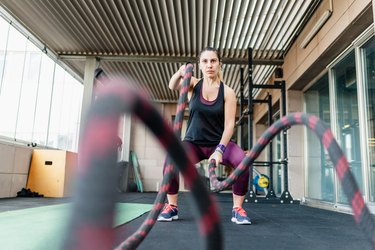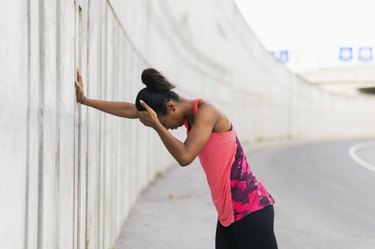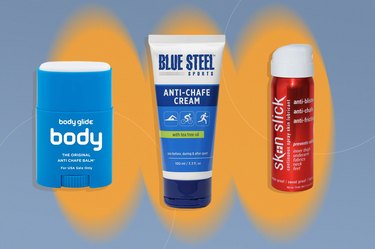
Sweating during your workouts might seem like an inconvenience, but sweat actually plays an important role in your body's response to heat and can serve as the key to better performance.
"[Sweat] is your body's physiological response to the heat. It's a way to regulate our body temperature. When sweat accumulates on your skin, it subsequently evaporates off of your skin's surface and transfers heat away from your body and into the environment," says Lindsay Baker, PhD, FACSM, director of the Gatorade Sports Science Institute.
Video of the Day
Video of the Day
"During exercise, sweating is the primary way of heat loss. If we didn't have that capacity to cool our bodies, we would be very limited in the amount of physical activity we can endure."
Because sweat is your body's way of cooling down, it's also an indicator of how much fluid you need to replenish during and after your workout. This is because sweat originates from the water in your body. More specifically, it's from blood plasma (water portion in your blood), which contains electrolytes, Baker explains.
How Electrolytes Help With Hydration
Electrolytes include minerals like sodium, chloride and potassium, but sodium and chloride are lost in the greatest concentration in sweat, according to Baker. That's why you need to be thinking beyond just plain H2O when rehydrating during and after exercise.
"Electrolytes are essential in hydrating your cells as they enable fluids to efficiently move throughout the body," says Jamie Meeks, RD, CSSD, LDN, director of sports nutrition for the New Orleans Saints.
"These charged minerals, including sodium, potassium, chloride, calcium and magnesium, dissolve in water and help conduct electrical impulses that facilitate numerous bodily functions, such as regulating balance, transmitting nerve impulses, maintaining heart rhythm and contracting muscles."
Sodium is important for maintaining blood plasma, which is essential for blood flow and proper organ function. Blood flow delivers nutrients and fluid to your muscles during exercise so you can continue to perform at a high level, Baker says. When you're at an electrolyte deficit, you may start to fatigue faster and notice that you're not able to perform as well as you normally do.
So how much should you be hydrating before, during and after your workouts? That depends on what type of sweater you are, in addition to the intensity of your workout and the environment.
Why Some People Sweat More Than Others
If you're wondering why you're sweating more or less than the person next to you at your fitness class, how much you sweat actually has a lot to do with genetics and your own body mass, aside from the intensity, duration and the environment of your workout.
Body Size
If you're doing a group workout class and the person next to you rates the intensity of the workout the same as you, but they're completely drenched and you're only lightly sweating, it likely means they have more mass to move. More mass (a larger body) has to exert more energy.
"[Sweat rate] is about the absolute exercise intensity versus relative exercise intensity. For example, a guy much taller and larger than you has a larger energy expenditure so they're going to be working harder, even though you both might rate the workout at the same intensity," Baker explains. "Because he's creating more heat than you, he needs to sweat more to dissipate heat. So a person's body size plays a big role."
Hydration Status
Your own hydration status, aka how much fluid you drink before, during and after your workout, can also affect your sweat rate. Generally, someone who is dehydrated or hasn't consumed enough water before exercise may produce less sweat and reduce their body's ability to dissipate heat than a person who is well-hydrated, Meeks says.
Training Level
Whether a person is aerobically fit or endurance-trained and used to working out in a hot environment plays a big factor, too. Someone who is more acclimated to working out in the heat and doing endurance sports will start to sweat earlier in the workout and will sweat more because their body is more efficient at losing the heat that they're generating, Baker says.
Genetics
A person's genetics also determines what type of sweater they are and how much fluid and electrolytes they need for hydration.
"Your genes play a crucial role in determining the number and distribution of sweat glands, as well as the volumes of different electrolytes and metabolites present in perspiration," Meeks says. "Some individuals may produce sweat that is richer in sodium or potassium compared to others, which can impact the likelihood of developing dehydration or muscle cramping during prolonged exercise."
The average person produces one liter of sweat per hour of exercise, but there is a wide range of how much fluid a person can lose, depending on the environment you're in and the intensity and duration of your workout, Baker says.
Environment
A small May 2021 study in Nutrients, which included 13 endurance-trained athletes who biked or ran for at least 30 minutes once a week for 24 weeks, found that there were significant differences in sweat rate based on low, moderate and high temperatures on a wet bulb globe thermometer.
According to the Korey Stringer Institute at the University of Connecticut, a wet bulb globe thermometer takes into account the ambient temperature, relative humidity, wind and solar radiation from the sun to measure environmental stress on the body during exercise.
On the low end, there was an average difference of 0.15 liters per hour in sweat rate. In moderate conditions, the average difference in sweat rate was 0.14 liters per hour, and in high conditions, the average difference in sweat rate was 0.16 liters per hour. Although there were no significant differences in sweat rate between low and moderate conditions, there were between low and high and moderate and high conditions.
How to Measure Your Sweat Rate
The type of sweater you are (your sweat rate) along with the intensity and length of your workout determines the best ways to optimize your hydration needs. Your needs change depending on if you're a light, moderate or heavy sweater.
"Before starting your workout, make sure you drink enough water to adequately hydrate your body," Meeks says. "It is recommended to drink at least 16 to 20 ounces of water two to three hours before exercise."
Starting out hydrated will help you better be able to determine your actual sweat rate. Weighing yourself before and after exercise is one of the most accessible ways to measure your sweat rate, but there are many factors to consider in your calculation, such as how much fluid you drink before and during your workout and the amount of sweat trapped in your clothing.
With that in mind, recent technology has been developed to help make not only measuring your sweat rate but also your electrolyte loss more readily available.
For example, the Gx Sweat Patch can be worn on your forearm during your workout. After exercising, you can log into the Gatorade Gx app and take a picture of your patch, which allows it to calculate your sweat rate and fluid and sodium loss.
Nix Biosensors attaches a biosensor to a patch, which measures sweat throughout your workout. Through the Nix Biosensor app, you'll get notifications during exercise when you should take sips of your sports drink. At the end of your workout, it calculates your fluid and electrolyte loss as well as your sweat composition. It also offers suggestions on sports drinks that best align with your hydration needs.
When it comes to how much fluid loss you should replace, consuming at least 16 to 20 ounces of water or fluid for every pound of weight lost post-workout is the general guideline, Meeks says. So if you lost two pounds during exercise, you should aim to drink 32 ounces of fluid.
In terms of electrolytes, replacing at least 50 percent of your electrolyte or sodium losses during exercise is sufficient for maintaining exercise performance and fluid/electrolyte balance, Baker says.
It's best to consult a sports dietitian to help you figure out the best sports drink or electrolyte supplement that will fit your needs. Sports drinks and electrolytes vary in the amount of sodium, potassium, magnesium and carbohydrates they contain. Working with a sports dietitian can help you evaluate your overall fluid and electrolyte loss during exercise and design a rehydration plan that suits your goals.
And when designing a hydration plan, you should not only consider your own sweat rate but also the intensity, duration and the environment of your workout.
A May 2019 study in the Journal of Sports Sciences, which Baker co-wrote and helped conduct, shows the large variance in sweat rates among athletes. American football players had the highest sweat rates of greater than approximately 1.51 liters per hour, followed by endurance athletes at 1.28 liters per hour, then baseball and soccer players at 0.95 and 0.94 liters per hour and finally, baseball players at 0.83 liters per hour.
What Type of Sweater Are You?
Light | Moderate | Heavy | Very Heavy |
|---|---|---|---|
Less than 0.8 L/h | About 0.8 to 1.2 L/h | About 1.2-1.5 L/h | Greater than 1.5 L/h |
If You're a Light Sweater or Doing a Short Workout
Folks who sweat less or are doing a workout that's 30 minutes long or less probably don't need to take in electrolytes from sports drinks and can just consume plain water before, during and after their workout.
"If you're someone who tends to sweat less or is engaging in a workout session that is relatively shorter workout and not too demanding, it is still crucial to keep yourself hydrated," Meeks says.
You can maintain your fluid levels and keep your electrolytes balanced during exercise by taking small sips of water regularly, somewhere between 7 to 10 ounces every 10 to 20 minutes, Meeks says.
After your workout, you should still drink plenty of fluids to replace what you lost. If you're doing the weighing route to try to determine how much your lost, keep in mind that if you drink fluids before and during your workout, that will affect the total difference at the end.
"A good rule of thumb is to pay attention to your body. How many times a day am I going to the bathroom? You should be going 5 to 7 times a day, anything less than that means that you may not be drinking enough. Pale yellow urine indicates good hydration, but anything darker, like apple juice, means you need to be drinking more water leading up to the workout," Baker says.
However, if you're a light sweater and are doing a longer workout, say an hour or more, and are outside in sunny weather, that may put you in the moderate sweater range. In this case, a standard sports drink can be helpful in replacing electrolyte losses.
According to an August 2016 review in the International Journal of Sport Nutrition and Exercise Metabolism, sweat typically contains 40 to 60 mmol/L of sodium, or 920 to 1,380 milligrams, which means that about 20 to 90 mmol (460 to 2,070 milligrams) of sodium is lost in one workout with sweat rates of 0.5 to 1.5 liters per hour.
How Much Sodium Is in Your Sports Drink?
Gatorade Thirst Quencher | Powerade | Liquid I.V. Hydration Multiplier | Nuun Sport | Pedialyte Sport |
|---|---|---|---|---|
160 mg per serving | 400 mg per serving | 500 mg per serving | 300 mg per serving | 490 mg per serving |
If You're a Moderate Sweater or Doing a Longer and More Intense Workout
If you consider yourself to be a moderate sweater or are working out more than 30 minutes at higher intensities and temperatures, then you need to hydrate more and make a greater effort to replace electrolytes.
Meeks recommends the same guidelines for moderate sweaters of consuming at least 16 ounces of water two to three hours before your workout and aiming to drink every 15 to 20 minutes during it to stay properly hydrated.
"If you're doing an especially intense workout or if you're sweating profusely, you may need to drink more often than that. Water is a great choice for staying hydrated, but if you're doing a prolonged workout, sports drinks can help to replenish electrolytes lost through sweat and can provide an energy boost," Meeks says.
Post-workout, aim to drink 16 to 20 ounces of water and/or a sports drink for every pound of body weight you lost during your workout to help prevent muscle cramps, fatigue and dehydration, Meeks adds. Choosing a sports drink with sodium can help replenish your electrolyte losses, which helps with maintaining hydration and fending off cramping.
If You're a Heavy Sweater or Doing an Intense Endurance Workout
Salty, heavy sweaters or those who are training an hour or more can benefit most from consuming an enhanced electrolyte drink with carbohydrates to help with performance goals, Baker says. Carbohydrates help replace your glycogen stores, which provide energy to your muscles.
The American College of Sports Medicine recommends people consume 30 to 60 grams of carbohydrates (0.7 grams per kilogram of body weight) per hour during exercise, according to a May 2014 review in Sports Medicine.
"Different brands and flavors of sports drinks may vary in their nutritional content. However, as a general rule, sports drinks are often formulated to provide a quick source of energy and hydration for athletes and active individuals," Meeks says. "Carbohydrates are a key macronutrient in sports drinks, as they provide the quick energy needed for physical activity."
Most sports drinks contain 15 to 20 grams of carbohydrates per serving from glucose, fructose and sucrose. These simple carbohydrates not only provide energy, but also improve endurance and delay fatigue from intense exercise, Meeks says.
For example, a 28-ounce Gatorade Thirst Quencher has 22 grams of carbohydrates per serving, while a 20-ounce Vitamin Water Power-C has 27 grams of carbohydrates per serving.
Heavy sweaters and those doing prolonged intense exercise for more than an hour should drink around 16 to 20 ounces of water/sports drink before their workout and at least 7 to 10 ounces of water/sports drink every 10 to 20 minutes during the workout, Meeks recommends. Post-workout, you should rehydrate by consuming at least 16 to 20 ounces of water or fluid for every pound of body weight lost during exercise.
Are You a Salty Sweater?
Similar to sweat rate, the sodium concentration in your sweat depends largely on your exercise intensity, your heat acclimation status and genetics.
"Sweat sodium concentration increases as you exercise at higher intensities. However, if you exercise in the heat for several consecutive days, your body will adapt by decreasing sweat sodium concentration to conserve salt losses over time," Baker explains.
Your genetics play a role, too, in your sweat sodium concentration. As Meeks pointed out earlier, your genes help determine the number and distribution of sweat glands you have and the volume of electrolytes in your sweat. Some people produce sweat that is richer in sodium than others.
"Sweat sodium concentration in the average active person is about 42 mmol/L or 970 milligrams per liter of sweat. A salty sweater has a sodium concentration about 1.5 to 2 times higher — i.e., in the range of 65 to 80 mmol/L (1,500 to 1,800 milligrams of sodium per liter of sweat)," Baker says.
Those who lose more than 2,000 to 3,000 milligrams of sodium per liter during their workout are considered very salty sweaters and should make a greater effort to consume salt with their drink during exercise, she says. Enhanced electrolyte drinks, like Gatorade Endurance Formula, for example, have higher amounts of sodium.
But remember, total sodium loss also depends on your sweat rate and the duration of your workout, so someone with average sweat saltiness and sweat rate who exercises for a long period of time, like two to three hours, could also be at risk for high salt losses, Baker says.
- Nutrients: "A Case-Series Observation of Sweat Rate Variability in Endurance-Trained Athletes"
- International Journal of Sport Nutrition and Exercise Metabolism: "Does Replacing Sodium Excreted in Sweat Attenuate the Health Benefits of Physical Activity?"
- Korey Stringer Institute at the University of Connecticut: "Wet Bulb Globe Temperature Monitoring"
- Journal of Sports Sciences: "Normative Data for Sweating Rate, Sweat Sodium Concentration, and Sweat Sodium loss in Athletes: An Update and Analysis by Sport"
- Sports Medicine: "A Step Towards Personalized Sports Nutrition: Carbohydrate Intake During Exercise"


